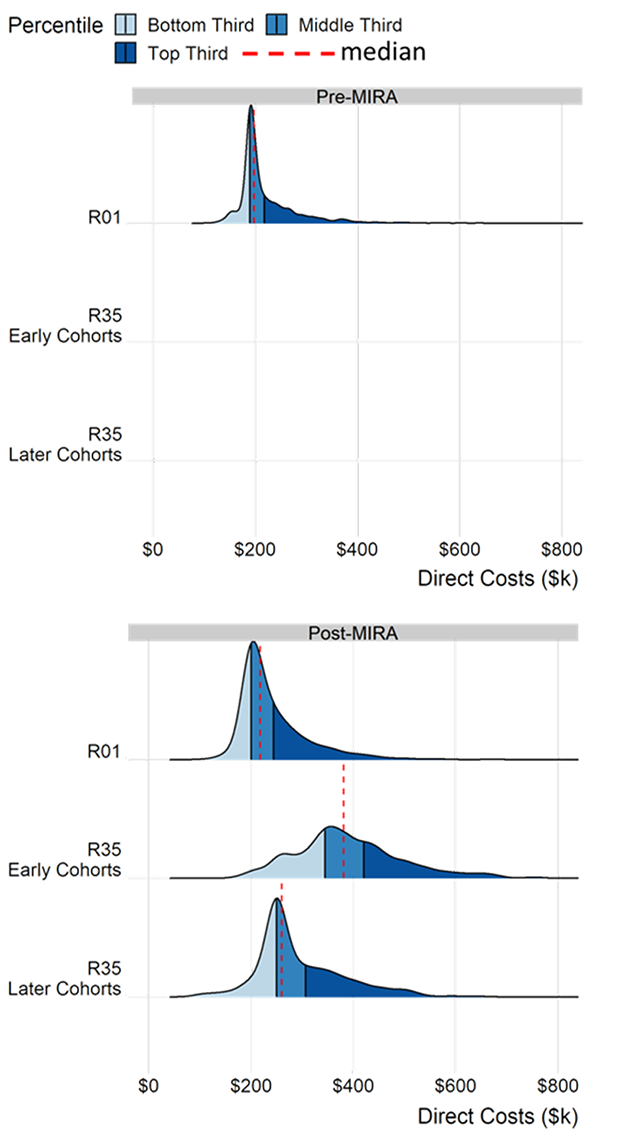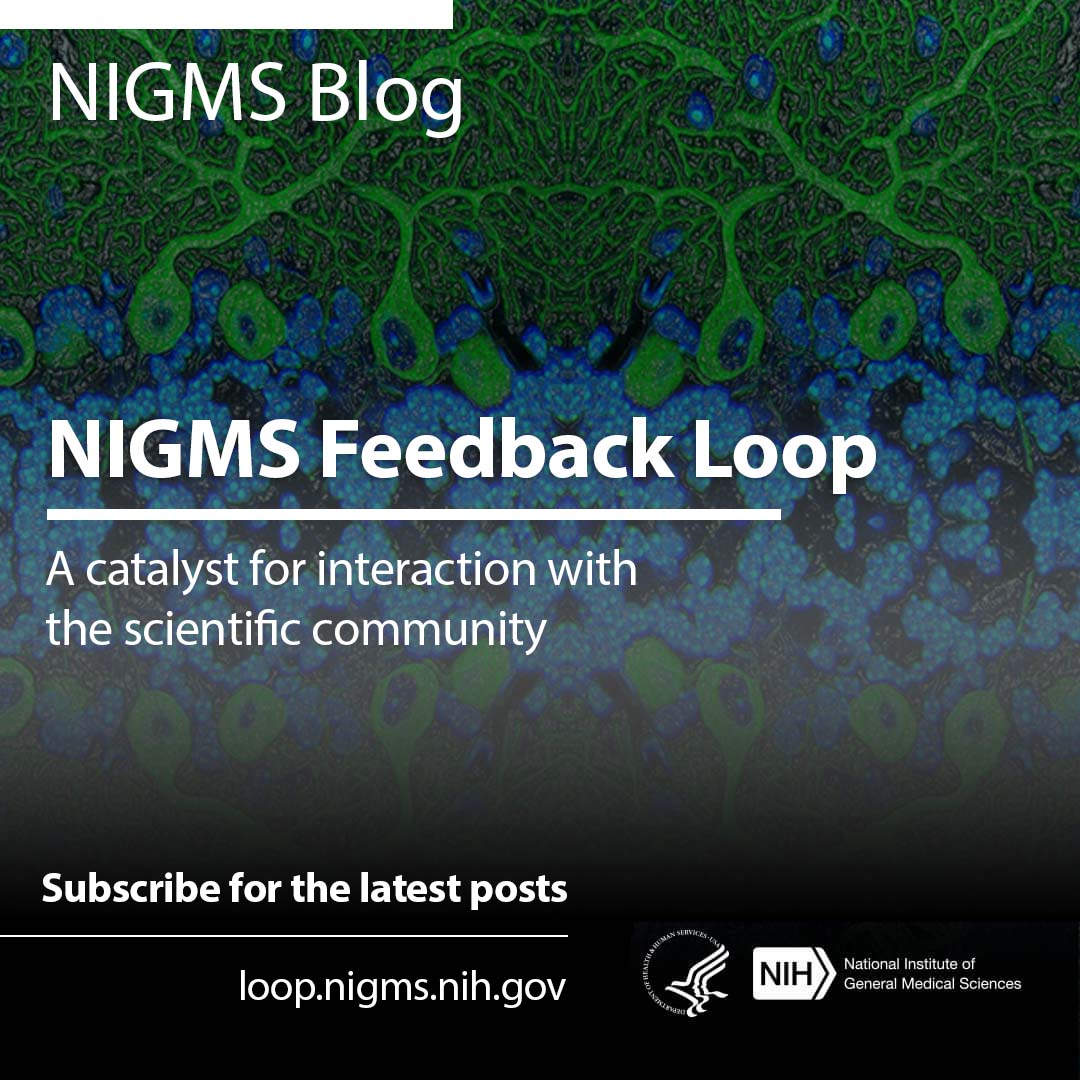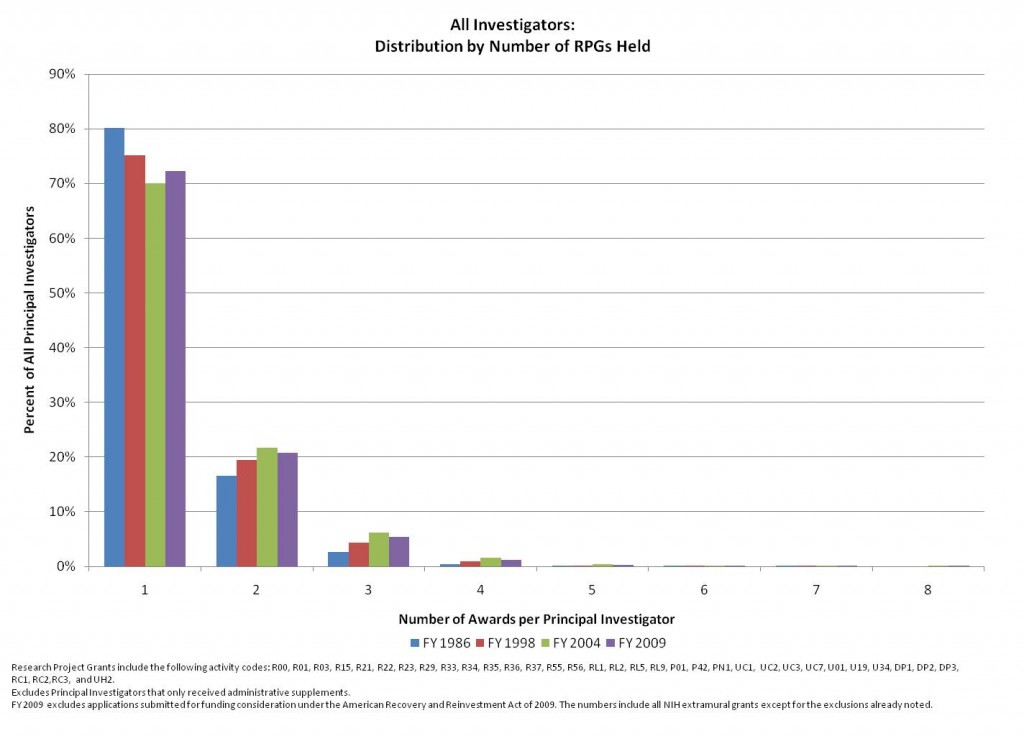- Joined
- Jan 5, 2002
- Messages
- 2,909
- Reaction score
- 2,940
Freshly saw this through NIH's mass mailing today:
First R01 20 years after matriculation from a T32?! Realizing that the inflection point is more at the 10 year mark, but still. That's some dedication, but really at that juncture, what's the point?
I suppose that possible. Most biomedical research is funded by the NIH, but certainly there is foundation support. Though I thought that was dwindling too? It is certainly more common than it used to be of having gaps in funding. Either way, it would certainly be interesting to know for those late first R01s, where the support came from.This is only weird if you imagine a research career is synonymous with continuous R01 support. It's probable that some people in that 20-y group may have left science and later returned, but I would imagine many of them had relatively continuous research careers that happened to be supported by non-R01 type funding (e.g. CDC, PCORI, European mechanisms, industry/pharma, foundation, or even just non-R01 NIH mechanisms like R21, R34, U series etc).
Thinking about the biosketches I've seen lately, I don't see too many people who are continuously supported on back-to-back R01s. Most of them have a much broader mix of funding in their histories. I have a family member who is a basic scientist and has been on the same two R01s continuously renewed for the past 30+ years, but that's not a model I see too much in the more clinical/translational environment where I work. People in my area with R01s seem to mostly have them for a specific ~5-year project which is over when it's over.
"Matriculation" means enter, so matriculating into a postdoctoral T32 is equivalent to graduating from graduate school or medical residency. Given that postdocs are 4-8 years long, and K awards are 4 years long, it's not that crazy that people take at least 10 years to win an R. Twenty is pretty crazy, but plenty of MD-PhDs maintain a loose connection to research throughout their career, and plenty of PhDs can get tenure at lower-ranked institutions that do not require an R.I suppose that possible. Most biomedical research is funded by the NIH, but certainly there is foundation support. Though I thought that was dwindling too? It is certainly more common than it used to be of having gaps in funding. Either way, it would certainly be interesting to know for those late first R01s, where the support came from.
I suppose that’s fair. I guess the people I know, including myself, had about 5 or 6 years from entering into a T32 and having a K, and another 5 years between starting a K and starting an R, give or take a year or two. My experience is also colored by the “up or out” by year 8 of faculty if there’s no R award, which clearly varies amongst institutions."Matriculation" means enter, so matriculating into a postdoctoral T32 is equivalent to graduating from graduate school or medical residency. Given that postdocs are 4-8 years long, and K awards are 4 years long, it's not that crazy that people take at least 10 years to win an R. Twenty is pretty crazy, but plenty of MD-PhDs maintain a loose connection to research throughout their career, and plenty of PhDs can get tenure at lower-ranked institutions that do not require an R.
Characteristic | Top 1% | Bottom 99% |
|---|
| Funding in $Million | Median (IQR) | 4.8 (4.0 to 6.5) | 0.4 (0.3 to 0.7) |
Maybe you don't want to spoil it... but are they Nobel laureates? I would imagine Jennifer Doudna is one of them.I am collaborating with several other investigators and have a preliminary article in peer-review about that group of investigators (super-PIs).
Funding in $Million Median (IQR) 4.8 (4.0 to 6.5) 0.4 (0.3 to 0.7)
I hope the NIH is getting their money's worth out of those in the top 1%.
See there’s a rub there. They based this on total cost (directs plus indirects). I don’t know if they accounted for that in the methods (I didn’t read it that close). But my RPG beats that median only because of the indirects where my institution charges 70 cents on the dollar.. Hell, I’ll take what I can get, but since indirect rates are wildly different between institutions, that would automatically lead to institution inequality.I'm interested in the Gini index of the distribution to something that has more intuition (i.e. income of US, etc).
The median funding level as a PI is about 0.4M per year, so if you are above that you'd be an above-average PI. This is actually very useful info. If you want to end up at a top university you should probably be above median at least... which more or less is true.
Oooo!!! Including indirects: I beat the median!!I'm interested in the Gini index of the distribution to something that has more intuition (i.e. income of US, etc).
The median funding level as a PI is about 0.4M per year, so if you are above that you'd be an above-average PI. This is actually very useful info. If you want to end up at a top university you should probably be above median at least... which more or less is true.
Exactly. She helped discover CRISPR-Cas9 system and got to share the Nobel prize… so I can understand why she gets so much.Jennifer Doudna - active funding:
RePORT 〉 RePORTER
reporter.nih.gov
Your university must have nicer toilets than all those lowly low indirect schools. What a perk!Oooo!!! Including indirects: I beat the median!!
Just to follow up on this, the paper that Jennifer Doudua co-published in 2013 based on NIH-funded research in 2012.Exactly. She helped discover CRISPR-Cas9 system and got to share the Nobel prize… so I can understand why she gets so much.
Incidently, I remember reading somewhere that most Nobel laureates get their prize based on discoveries they made early in their career, like late 30s to late 40s or so. Makes the idea of giving the most money to the most senior people seems like a fools errand in that regard.
Edit: I guess that data is old. The average age in mid to late 50s. Well, still makes the idea of giving lots of money to 70 year olds unlikely to be fruitful but I’d love to see that data of how success is actually measured besides the most forgotten papers in journal X.



What's the source on that chart? The R01 funding doesn't make a whole lot of sense to me. Max annual directs budget on R01 at NCI is $500k and it seems like most grants try to max that out. Is NIGMS R01 budget smaller?
This figure (Inequalities in the distribution of National Institutes of Health research project grant funding) makes more sense to me. Most R01 or similar grants in the $250-500k range with some people with multiple large grants or large project grants.


From the paper: From the NIH IMPAC II database, we obtained PI-specific data on inflation-adjusted total-cost funding of Research Project Grants (RPGs), defined as those grants with activity codes of DP1, DP2, DP3, DP4, DP5, P01, PN1, PM1, R00, R01, R03, R15, R21, R22, R23, R29, R33, R34, R35, R36, R37, R61, R50, R55, R56, RC1, RC2, RC3, RC4, RF1, RL1, RL2, RL9, RM1, UA5, UC1, UC2, UC3, UC4, UC7, UF1, UG3, UH2, UH3, UH5, UM1, UM2, U01, U19, and U34.
This is the correct number as I have numerously cited in various posts. It's between 15-20%. This number is also decreasing. High-end programs anecdotally it's maybe around 30%, though there's a steeper drop in recent cohorts in high-end programs, as several alternatives became more appealing (industry, high-end private practice/procedural specialties, etc).According to Table 3 in the Inequalities article, 651 MD/PhDs who are less than or equal to 45 years old have an R01 or similar grant.
Table 5 of the Long Term Trends paper says that age 45 is about 70th percentile for first R01 award.
So that means 651 * 1.3 = 846 MD PhDs of the early career cohort are predicted to eventually get an R01.
According to AMA, about 600 students graduate MD PhD programs per year. If the average MD/PhD takes 8 years, then 846/600/8 = 0.176. So these back of the envelope calculations suggest that only 17.6% of the recent MD/PhD graduates are predicted to earn an R01 in their career.
